|
|
 |
|
Cyclopoida ( Order ) |
|
|
|
Oncaeidae ( Family ) |
|
|
|
Triconia ( Genus ) |
|
|
| |
Triconia minuta Giesbrecht, 1892 (F, M) | |
| | | | | | | Syn.: | Oncäa minuta Giesbrecht, 1892 (p.591, 603, 774, Descr.F, figs.F);
Oncaea minuta : Thompson & Scott, 1903 (p.239); Esterly, 1905 (p.217, figs.F); Farran, 1908 b (p.92, Rem.); A. Scott, 1909 (p.242, Rem.); Pesta, 1912 a (p.58); non Sars, 1918 (p.217, figs.F, Rem.: p.218); Wilson, 1932 a (p.352, figs.F); Rose, 1933 a (p.298, figs.F); Wilson, 1942 a (p.198, fig.F); Bainbridge, 1972 (p.61, Appendix Table II, vertical distribution %); Razouls, 1972 (p.95, Annexe: p.116, figs.F); Chen & al., 1974 (p.43, figs.F); no Razouls, 1974 b (p.240, figs.F); Shuvalov, 1976 (in Kos, 1976, Vol. II, figs.F, Rem.); Dawson & Knatz, 1980 (p.9, figs.F); Björnberg & al., 1981 (p.668, figs.F); Malt, 1983 a (p.6, fig.F, Rem.); Malt & al., 1989 (p.959, Rem.M); Böttger-Schnack, 1990 (p.869, tab.III); Ohtsuka & al., 1996 a (p.91); Chihara & Murano, 1997 (p.981, Pl.225: F); Boxshall, 1998 (p.226); Conway & al., 2003 (p.222, figs.F, Rem.);
Ref. compl.: Wilson, 1932 (p.50); Massuti Alzamora, 1942 (p.103, Rem.); Sewell, 1948 (p.393, 461, 487); C.B. Wilson, 1950 (p.272); Grice, 1956 (p.68); Fagetti, 1962 (p.43); Gaudy, 1963 (p.32, Rem.); Björnberg, 1963 (p.81, Rem.); Unterüberbacher, 1964 (p.34, Rem.: ?); Shmeleva, 1965 b (p.1350, lengths-volume -weight relation); Furuhashi, 1966 a (p.295, vertical distribution in Kuroshio region, Table 9);Mazza, 1966 (p.73); Pavlova, 1966 (p.45); Delalo, 1968 (p.139, Rem.: ?); Tsalkina, 1970 (p.507); Kovalev, 1970 (p.91, Tableau 1, 2, fig., egg production); Deevey, 1971 (p.224); Salah, 1971 (p.320); Apostolopoulou, 1972 (p.329, 379); Zalkina, 1977 (p.339, tab.1); Dessier, 1979 (p.207); Vaissière & Séguin, 1980 (p.23, tab.1); Vives, 1982 (p.295); Kovalev & Shmeleva, 1982 (p.85); Tremblay & Anderson, 1984 (p.7, Rem.); Greze & al., 1985 (p.8); Jansa, 1985 (p.108, Tabl.I, II, III, IV); Brinton & al., 1986 (p.228, Table 1); Böttger-Schnack & al., 1989 (p.1089); Kosobokova, 1989 (p.26); Böttger-Schnack, 1992 (p.304); 1994 (p.277); Kosobokova & al., 1995 (p.194); Shih & Young, 1995 (p.77); Böttger-Schnack, 1995 (p.92); 1997 (p.409); Kosobokova & al., 1998 (tab.2); Suarez-Morales & Gasca, 1998 a (p.112); Noda & al., 1998 (p.55, Table 3, occurrence); Siokou-Frangou, 1999 (p.479); Kosobokova & Hirche, 2000 (p.2029, tab.2); El-Sherif & Aboul Ezz, 2000 (p.61, Table 3: occurrence); Daly Yahia & al., 2004 (p.366, fig.4); Lan & al., 2004 (p.332, tab.1); Prusova & Smith, 2005 (p.76, 78); Khelifi-Touhami & al., 2007 (p.327, Table 1); Zakaria, 2007 (p.238, Table 2, spatial distribution); Hwang & al., 2007 (p.25); C.-Y. Lee & al., 2009 (p.151, Tab.2); Lidvanov & al., 2010 (p.356, Table 3); Fazeli & al., 2010 (p.153, Table 1); Moscatello & al., 2011 (p.80, Table 4); Kâ & Hwang, 2011 (p.155, Table 3: occurrence %); Hsiao & al., 2011 (p.317, Table 2, indicator of seasonal change); Selifonova, 2011 a (p.77, Table 1, alien species in Black Sea); Uysal & Shmeleva, 2012 (p.909, Table I); DiBacco & al., 2012 (p.483, Table S1, ballast water transport); Tseng & al., 2013 (p.507, seasonal abundance); Lidvanov & al., 2013 (p.290, Table 2, % composition); Pansera & al., 2014 (p.221, Table 2, abundance); Zaafa & al., 2014 (p.67, Table I, occurrence);
? Oncaea sp.A: Razouls, 1974 (p.241, Fig.16) | | | | Ref.: | | | Böttger-Schnack, 1999 (p.43, 70, Redescr.F,M, figs.F,M, Rem.); Di Capua & Boxshall, 2008 (p.1410, figs.F, table 1); Vives & Shmeleva, 2010 (p.344, figs.F,M, Rem.); Böttger-Schnack & Machida, 2011 (p.111, Table 1, 2, fig.2, 3, DNA sequences, phylogeny) | 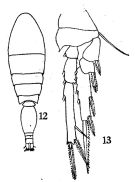 issued from : Q.-c Chen & S.-z. Zhang & C.-s. Zhu in Studia Marina Sinica, 1974, 9. [Pl.7, Figs.12-13]. Female (from China Seas): 12, habitus (dorsal); 13, P4.
|
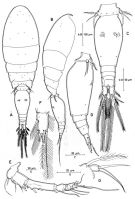 issued from : R. Böttger-Schnack in Mitt. hamb. zool. Mus. Inst., 1999, 96 [p.72, Fig.14]. Female (from Red Sea): A, habitus (dorsal); B, idem (lateral right side); C, urosome (dorsal); D, idem (lateral left side); E, A1; F, caudal ramus (dorsal); G, P5 (dorsal). Nota: Proportional lengths (%) of urosomites and caudal rami 10.2:54.9:6.4:5.7:11.0:11.7. A1 6-segmented, relative lengths (%) of segments of A1 measured along posterior non-setigerous margin 13.2:21.3:39.4:11.7:5.9:8.5. Caudal ramus about 1.7 times as long as wide. Anal somite 1.2 times wider than long, about same length as caudal rami.
|
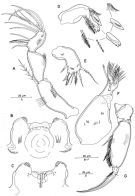 issued from : R. Böttger-Schnack in Mitt. hamb. zool. Mus. Inst., 1999, 96 [p.73, Fig.15]. Female: A, A2 (anterior); B, labrum (anterior); C, idem (posterior); D, Md (showing individual elements); E, Mx1; F, Mx2; G, Mxp.
|
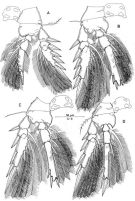 issued from : R. Böttger-Schnack in Mitt. hamb. zool. Mus. Inst., 1999, 96 [p.74, Fig.16]. Female: A, P1 (posterior); B, P2 (anterior); C, P3 (anterior); D, P4 (anterior). Nota: The length of the outer subdistal spine on P4 endop-3 was slightly smaller than the outer distal spine in the Red Sea specimens, whereas in specimens from the Gulf of Naples both spines are equal in length (Giesbrecht;, 1892, Pl.47, Fig.59). Thes differences, however, can be regarded as variation between specimens (as found for instance also in T. dentipes.
|
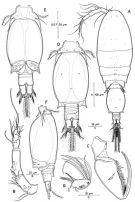 issued from : R. Böttger-Schnack in Mitt. hamb. zool. Mus. Inst., 1999, 96 [p.76, Fig.17]. Male (from Red Sea): A, habitus (dorsal); B, A1; C, Mxp (anterior); D, urosome (dorsal); E, idem (ventral); F, idem (lateral left side); G, A2 (distal endopod segment). Nota: A1 4-segmented, relative lengths (%) of segments of A1 measured along posterior non-setigerous margin 8.8:23.5:39.4:28.2. P6 represented by posterolateral flap closing off genital aperture on either side, covered by pattern of spinules.
|
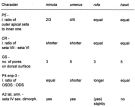 issued from : R. Böttger-Schnack in Mitt. hamb. zool. Mus. Inst., 1999, 96 [p.77, Table 3]. Morphological characters separating males of Triconia minuta, T. umerus, T.rufa and T. hawii. ODS = outer distal spine; OSDS = outer subdistal spine; endp-3 = 3th endopod segment; l = length; sex dimorph. = sexually dimorphic; GS = genital somite; P4, P5 = thoracopods 4, 5; A2 = antenna; CR = caudal rami; lat. arm = lateral armature.
|
 issued from : G.O. Sars in An Account of the Crustacea o Norway, 1918, VI. [Pl. CXVIII, 2]. As Oncaea minuta.
|
 Issued from : W. Giesbrecht in Systematik und Faunistik der Pelagischen Copepoden des Golfes von Neapel und der angrenzenden Meeres-Abschnitte. – Fauna Flora Golf. Neapel, 1892, 19 , Atlas von 54 Tafeln. [Taf.47, Figs.3, 26]. Female: 3, habitus (lateral); 26, same (dorsal).
|
 Issued from : W. Giesbrecht in Systematik und Faunistik der Pelagischen Copepoden des Golfes von Neapel und der angrenzenden Meeres-Abschnitte. – Fauna Flora Golf. Neapel, 1892, 19 , Atlas von 54 Tafeln. [Taf.47, Fig.6]; Female: 6, urosome (dorsal).
|
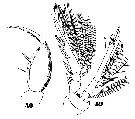 Issued from : W. Giesbrecht in Systematik und Faunistik der Pelagischen Copepoden des Golfes von Neapel und der angrenzenden Meeres-Abschnitte. – Fauna Flora Golf. Neapel, 1892, 19 , Atlas von 54 Tafeln. [Taf.47, Figs.46, 59]. Female: 46, Mxp; 59, P4.
| | | | | Compl. Ref.: | | | Böttger-Schnack & al., 2001 (p.1029, tab.1, 2); Hsieh & al., 2004 (p.398, tab.1); Krsinic & Grbec, 2002 (p.127, tab.1); Nishibe & Ikeda, 2004 (p.931, Tab. 2, 5); Böttger-Schnack & al., 2004 (p.1130, tab.1, Rem.); Böttger-Schnack, 2004 (p.220: tab.2, Rem.); Nishibe & al., 2009 (p.491, Table 1: seasonal abundance); Böttger-Schnack & Schnack, 2009 (p.131, Table 3, 4); Mazzocchi & Di Capua, 2010 (p.429); Dvoretsky & Dvoretsky, 2010 (p.991, Table 2); Salah S. & al., 2012 (p.155, Tableau 1); Shiganova & al., 2012 (p.61, Table 4); Gubanova & al., 2013 (in press, p.4, Table2); in CalCOFI regional list (MDO, Nov. 2013; M. Ohman, comm. pers.); Mazzocchi & al., 2014 (p.64, Table 5, abundance); Fierro Gonzalvez, 2014 (p.1, Tab. 3, 5, occurrence, abundance) ; Zakaria & al., 2016 (p.1, Table 1); Benedetti & al., 2016 (p.159, Table I, fig.1, functional characters); El Arraj & al., 2017 (p.272, table 2); Benedetti & al., 2018 (p.1, Fig.2: ecological functional group); Chaouadi & Hafferssas, 2018 (p.913, Table II: occurrence). | | | | NZ: | 20 + 1 doubtful | | |
|
Distribution map of Triconia minuta by geographical zones
|
| | | | | | | | | | | | | | |  issued from : A.V. Kovalev in Gidrobiol. Zh., 1970,
6 (5). [p.92, Table 1]. As Oncaea minuta. issued from : A.V. Kovalev in Gidrobiol. Zh., 1970,
6 (5). [p.92, Table 1]. As Oncaea minuta.
Relation between the body length of females and number of eggs.
A: species; B: number of females; C: length of females in mm; D: number of eggs in relation to the lengths of females. |
| | | | Loc: | | | Namibia (?), Congo, off Lagos, off Morocco-Mauritania, Cap Ghir, off Madeira Is., Argentina, S Brazil, Venezuela, Florida (Alligator Harbor), Sargasso Sea, off Bermuda, Chesapeake Bay, off S Newfoundland, Greenland, off W Ireland, Norway, North Sea, Ibero-moroccan Bay, off W Tangier, Medit. (M'Diq, Alboran Sea, Habibas Is., Sidi Fredj coast, Gulf of Annaba, Baleares, Banyuls, Ligurian Sea, Tyrrhenian Sea, Lake Faro (Sicily), Strait of Messina, N & S Adriatic Sea, Vlora Bay, Aegean Sea, Black Sea, Lebanon Basin, W Egyptian coast, Alexandria), ? Suez Canal, Sharm El-Sheikh, G. of Aqaba, Red Sea (N-S), Gulf of Oman, G. of Aden, Arabian Sea, NW & E Indian, Bay of Bengal, Indonesia-Malaysia, Sulu Sea, Philippines, China Seas (East China Sea, South China Sea), Taiwan Strait, Taiwan (S, W, NW, NE), Japan (Kuchinoerabu Is., Tosa Bay, Kuroshio & Oyashio regions), Bering Sea, Laptev Sea, Barents Sea, Canadian abyssal plain, Aleutian Is., G. of Alaska, California (San Pedro Bay), Gulf of California, W Mexico, G. of Panama, off Galapagos, off Hawaii, Peru, Fiji Is., Peru, off Chile | | | | N: | 109 ? | | | | Lg.: | | | (24) F: 0,76-0,68; M: 0,62; (45) F: 0,5-0,45; (46) F: 0,58-0,56; (109) F: 0,56-0,5; (133) F: 0,46; (142) F: 0,5-0,46; (237*) F: 0.45; (432) F: 0,62-0,45; (788) F: 0,56-0,5; M: 0,41-0,39; (810) F: 0,56-0,50; M: 0,41-0,39; (1014) F: 0,474; (1101) F: 0,41-0,55; {F: 0,41-0,76; M: 0,39-0,62}
*: probably noted 4.5 mm (lapsus calami) | | | | Rem.: | Meso-bathypelagic. Epipelagic in the Gulf of Naples. 582-820 m at Station T-1 (E Tori Is., E middle Japan) from Furuhashi (1966 a).
After Wi & al. (2011, p.603) T. umerus and T. denticulata co-occurred south of Cheju Island, where the Kuroshio Current provides the main inflow into the East China Sea and Sea of Japan via the Tsushima Warm Current and Cheju Warm Current. According to Hsieh and Chiu (2002) and Hsieh & al. (2004) T. minuta, like T. similis should be indicators of an intrusion of the Kuroshio Current in the East China Sea.
Esterly (1905, p.217) suggests that the male, figured by Aurivillius (1899, p.29, figs.1-3) could belong to this species, what could not be confirmed by Böttger-Schnack (1999).
For Böttger-Schnack (1999, p.78) many records of this species in the world ocean are cited, but are doubtful, because they did not include figures or a description that positively identified the species.
After Benedetti & al. (2018, p.1, Fig.2) this species belonging to the functional group 5 corresponding to small sac-spawning detritivorous.
See in remarks for Oncaea lacinia. | | | Last update : 25/10/2022 | |
|
|
 Any use of this site for a publication will be mentioned with the following reference : Any use of this site for a publication will be mentioned with the following reference :
Razouls C., Desreumaux N., Kouwenberg J. and de Bovée F., 2005-2025. - Biodiversity of Marine Planktonic Copepods (morphology, geographical distribution and biological data). Sorbonne University, CNRS. Available at http://copepodes.obs-banyuls.fr/en [Accessed December 27, 2025] © copyright 2005-2025 Sorbonne University, CNRS
|
|
 |
 |













